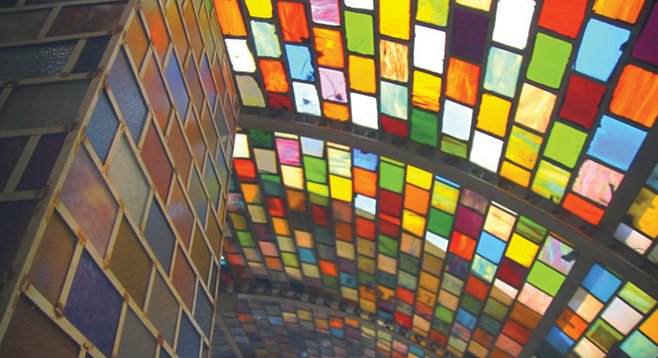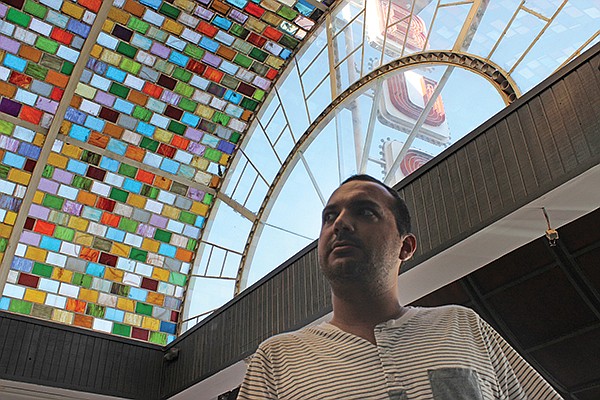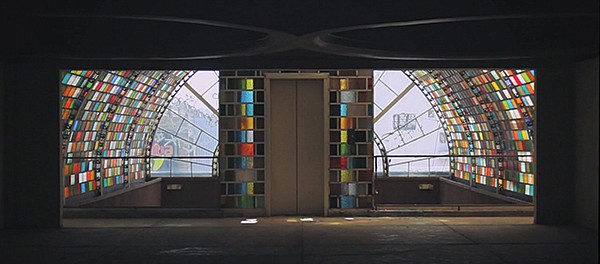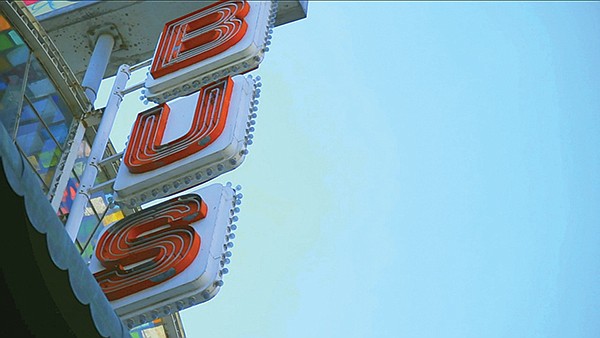 Facebook
Facebook
 X
X
 Instagram
Instagram
 TikTok
TikTok
 Youtube
Youtube

Miguel Buenrostro sits on the second floor of the old Mexicoach station, half a block from the nocturnal nexus of Sexta and Revolución. We are in a vacant, black-walled room that will soon be converted into a gallery highlighting architecture and urbanism. The gallery is just off to the side of a balcony overlooking Centro’s main drag, where a mash-up of absurd downtown TJ — police sirens, taxis honking and whooping, car alarms, the background chatter and boom of nightlife — is counterpointed by mellow jazz guitar being played down the hall. Above is an arched ceiling of stained glass built in 1983 as part of Pasaje Contreras, a tourist bus terminal and curio arcade.



“This was a very unique building, so we tried to respect it,” says Buenrostro, who founded a tech startup accelerator and co-working space called HUB STN (“Hub Station”) on the building’s second floor with partners Miguel Marshall (Angel Ventures Mexico) and Marco Soto (Startup Weekend Tijuana) under the guidance of Rene Peralta, a professor at Woodbury School of Architecture in Barrio Logan.
“The architecture is incredible, so for us it would be very sad if some businessman buys the property and tears it down and makes a titty bar or whatever. What we’ve tried to do since the beginning is to generate a space with different content that will be involved in the city’s development, right in the core of the city, which is here. We used what was already here and tried to develop a dynamic that would adjust to the space instead of tearing down walls or putting walls in between.”
Four years ago, Buenrostro started a photographic memoir of buildings around the city. The Mexicoach station stood out in part due to the nostalgia he’d attached to the eye-catching façade since childhood. At its prime, the station drew about 20,000 tourists weekly, a figure that dropped to about 100 during the violent era of the late 2000s and has since risen to 400, Buenrostro says. The bus to San Ysidro still stops out front daily.
“My approach was very much how you approach a documentary film or a portrait. You don’t show up with your camera and start shooting. You ask what happened in this space before, how this space has been transformed, how it has evolved, how the people who are involved react to it, and what are the possibilities of transformation. That is very important when we approach a building.”
Such was the case a few years ago when Buenrostro, working as Reactivando Espacios (“Reactivating Spaces”), negotiated with the property owners of defunct curio arcades Pasaje Gomez and Pasaje Rodriguez to reopen the passageways as a locale for galleries, cafés, and small businesses.
“The first spaces that we approached were strictly focused on art and culture,” Buenrostro says. “Sadly, there is not a solid art economy. So what we tried to make here is a mixture. We integrated an economical part but also a creative part. If you don’t have collaboration between the private sector and the public sector, us as a community, then it doesn’t work. So, we’ve tried to design a collaborative space.”
Now, members paying hourly or monthly fees can work over Wi-Fi in a common area that also hosts pitch nights, hackathons, and documentary screenings.
Arriving on the coattails of Tijuana tech accelerators and collaborative spaces such as MIND Hub, Sonata, Bit Center, and Index Open Studio, HUB STN’s small business center is currently rented out to bi-national companies, including Uber (a taxi app that is already operational in Mexico City), Angel Ventures (a capital investment fund with $40 million), a branding firm, and a startup-oriented law firm. It’s a one-stop shop for anyone with a bright idea and the gumption to see it through.
“We try to create an environment for technology, creative, and entrepreneurial projects, so you are always networking with other people,” Buenrostro says.
Buenrostro and company had been working on HUB STN for two years prior to opening the station’s doors for the first time in seven years last May. The ultimate vision includes a film-screening room, restaurants, an espresso stand, a bar, and a special-event space on the upper floor.
“Ideally, I would hope to see an investment fund on both sides of the border that is generating economy on both sides. It is very clear that the U.S. needs something from us and we need something from the U.S. We need to collaborate, and I think many people are aware of that right now. We don’t want to work for the maquiladoras. We don’t want to work for the corporations. We want to build our own sustainable economy. From a geographical point it is very strategic, and I think there is a world of possibilities that can emerge from this point that would benefit both sides.”
It makes sense. About 350 million people cross the international border every year, primarily to work in San Diego, which Forbes named the No. 1 place to launch a startup in 2014. Meanwhile, California tech companies are crossing south to hire engineers and programmers for around a third of the cost that they would pay up north. The intertwined economies of the post-NAFTA “Cali-Baja Mega-Region” is most notably illustrated by 3D Robotics, a civilian drone manufacturer based in Berkeley with engineering facilities in both San Diego and Tijuana. As manufacturing continues to move from China to Mexico (especially for short-run tech fabricators such as 3D Robotics) paralleled by a 30 percent increase in U.S./Mexico trade since 2010, Tijuana, observers say, is poised to become the international gateway for burgeoning tech into Latin America.
In 2016, Tijuana and San Diego will jointly host the World Forum for Foreign Direct Investment, the roving forum’s first binational installment.
“This city is the city of clichés,” Buenrostro says. “We are the city of prostitutes, titty bars, drunks. The city has been branded that way for so many years. And now I think the city has been branded as this vibrant city, a creative city, an artist’s city. And it’s cool. It sounds good. But it’s not exactly the truth. The truth is in between, on a day-by-day basis. That’s the region’s identity. That’s the core. That, for me, is more romantic than glory or decay. Our project has been part of that perspective — I get it — but I don’t want it to turn into another cliché of the ‘vibrant city.’ No. We need to talk about the day-by-day. The day-by-day is very beautiful.... It is unique, it is authentic, and it has the power to change things.”


Miguel Buenrostro sits on the second floor of the old Mexicoach station, half a block from the nocturnal nexus of Sexta and Revolución. We are in a vacant, black-walled room that will soon be converted into a gallery highlighting architecture and urbanism. The gallery is just off to the side of a balcony overlooking Centro’s main drag, where a mash-up of absurd downtown TJ — police sirens, taxis honking and whooping, car alarms, the background chatter and boom of nightlife — is counterpointed by mellow jazz guitar being played down the hall. Above is an arched ceiling of stained glass built in 1983 as part of Pasaje Contreras, a tourist bus terminal and curio arcade.



“This was a very unique building, so we tried to respect it,” says Buenrostro, who founded a tech startup accelerator and co-working space called HUB STN (“Hub Station”) on the building’s second floor with partners Miguel Marshall (Angel Ventures Mexico) and Marco Soto (Startup Weekend Tijuana) under the guidance of Rene Peralta, a professor at Woodbury School of Architecture in Barrio Logan.
“The architecture is incredible, so for us it would be very sad if some businessman buys the property and tears it down and makes a titty bar or whatever. What we’ve tried to do since the beginning is to generate a space with different content that will be involved in the city’s development, right in the core of the city, which is here. We used what was already here and tried to develop a dynamic that would adjust to the space instead of tearing down walls or putting walls in between.”
Four years ago, Buenrostro started a photographic memoir of buildings around the city. The Mexicoach station stood out in part due to the nostalgia he’d attached to the eye-catching façade since childhood. At its prime, the station drew about 20,000 tourists weekly, a figure that dropped to about 100 during the violent era of the late 2000s and has since risen to 400, Buenrostro says. The bus to San Ysidro still stops out front daily.
“My approach was very much how you approach a documentary film or a portrait. You don’t show up with your camera and start shooting. You ask what happened in this space before, how this space has been transformed, how it has evolved, how the people who are involved react to it, and what are the possibilities of transformation. That is very important when we approach a building.”
Such was the case a few years ago when Buenrostro, working as Reactivando Espacios (“Reactivating Spaces”), negotiated with the property owners of defunct curio arcades Pasaje Gomez and Pasaje Rodriguez to reopen the passageways as a locale for galleries, cafés, and small businesses.
“The first spaces that we approached were strictly focused on art and culture,” Buenrostro says. “Sadly, there is not a solid art economy. So what we tried to make here is a mixture. We integrated an economical part but also a creative part. If you don’t have collaboration between the private sector and the public sector, us as a community, then it doesn’t work. So, we’ve tried to design a collaborative space.”
Now, members paying hourly or monthly fees can work over Wi-Fi in a common area that also hosts pitch nights, hackathons, and documentary screenings.
Arriving on the coattails of Tijuana tech accelerators and collaborative spaces such as MIND Hub, Sonata, Bit Center, and Index Open Studio, HUB STN’s small business center is currently rented out to bi-national companies, including Uber (a taxi app that is already operational in Mexico City), Angel Ventures (a capital investment fund with $40 million), a branding firm, and a startup-oriented law firm. It’s a one-stop shop for anyone with a bright idea and the gumption to see it through.
“We try to create an environment for technology, creative, and entrepreneurial projects, so you are always networking with other people,” Buenrostro says.
Buenrostro and company had been working on HUB STN for two years prior to opening the station’s doors for the first time in seven years last May. The ultimate vision includes a film-screening room, restaurants, an espresso stand, a bar, and a special-event space on the upper floor.
“Ideally, I would hope to see an investment fund on both sides of the border that is generating economy on both sides. It is very clear that the U.S. needs something from us and we need something from the U.S. We need to collaborate, and I think many people are aware of that right now. We don’t want to work for the maquiladoras. We don’t want to work for the corporations. We want to build our own sustainable economy. From a geographical point it is very strategic, and I think there is a world of possibilities that can emerge from this point that would benefit both sides.”
It makes sense. About 350 million people cross the international border every year, primarily to work in San Diego, which Forbes named the No. 1 place to launch a startup in 2014. Meanwhile, California tech companies are crossing south to hire engineers and programmers for around a third of the cost that they would pay up north. The intertwined economies of the post-NAFTA “Cali-Baja Mega-Region” is most notably illustrated by 3D Robotics, a civilian drone manufacturer based in Berkeley with engineering facilities in both San Diego and Tijuana. As manufacturing continues to move from China to Mexico (especially for short-run tech fabricators such as 3D Robotics) paralleled by a 30 percent increase in U.S./Mexico trade since 2010, Tijuana, observers say, is poised to become the international gateway for burgeoning tech into Latin America.
In 2016, Tijuana and San Diego will jointly host the World Forum for Foreign Direct Investment, the roving forum’s first binational installment.
“This city is the city of clichés,” Buenrostro says. “We are the city of prostitutes, titty bars, drunks. The city has been branded that way for so many years. And now I think the city has been branded as this vibrant city, a creative city, an artist’s city. And it’s cool. It sounds good. But it’s not exactly the truth. The truth is in between, on a day-by-day basis. That’s the region’s identity. That’s the core. That, for me, is more romantic than glory or decay. Our project has been part of that perspective — I get it — but I don’t want it to turn into another cliché of the ‘vibrant city.’ No. We need to talk about the day-by-day. The day-by-day is very beautiful.... It is unique, it is authentic, and it has the power to change things.”
Comments